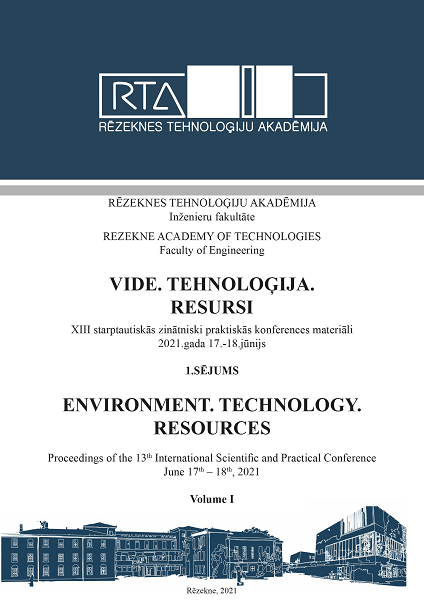STUDY OF CHANGES IN CURRANT DURING FAST FREEZING
DOI:
https://doi.org/10.17770/etr2021vol1.6539Keywords:
berries, currant, freezing, storageAbstract
Frozen berries have a number of undeniable advantages: they do not require additional preparation costs, are almost ready to eat, and most importantly, thanks to modern technologies, they retain almost twice as much nutrients as with other canning methods. Increasingly, there are risks associated with internal and external factors, as well as problems with excess yields that threaten not to sell the product fresh. short shelf life immediately after harvest, which increases the critical dependence on market prices. One of the progressive technological methods of processing fruit and berry products is quick freezing. The use of such freezing gives, first of all, a low degree of product damage, minimally reduces the biological value and taste characteristics, and the use of freezing does not significantly affect the quality of the thawed product.
The main task of an industrial or commercial line for shock freezing of berries is to ensure almost instantaneous preservation of the product, which will retain all its nutritional value and taste. This is usually achieved by rapidly chilling the berries to -18 °C. By far the best option for extending the shelf life of freshly cooked food is to freeze it quickly. There are various options, but the best known is the freezing technology. For instant freezing without crystallization, it is necessary to provide a temperature of -5 ...- 18 °C. Experimental data were obtained during research. The temperature regime of storage of currants with the preservation of quality indicators using a freezing device is also considered. When frozen quickly, the berries should be blown from all sides or literally float in a stream of frosty air of the appropriate temperature.
The duration of this process depends on the type and size of the berries, as well as on the intensity of the cooling air flow. The current direction in the field of research of frozen berries is the preservation of consumer properties of berries after freezingDownloads
References
Yalpachik V.F., Zagorko N.P. and Kiurchev S.V., Eds., Optimization of technology for frozen fruit and vegetable products: Monograph. Melitopol: Vidavnichy booth Melitopolskiy Myskoy Drukarniy, 2018.
Postolski J. and Gruda Z. Freezing of food products. Moskow: Food industry. 1978.
Kiurchev S., Glowacki S. and Verkholantseva V. “An innovative approach for storing berries in the modern”. Innovations in technology and equipment of hotel and restaurant, food and processing industries: international scientific-practical Internet conference, November 24, 2020. Melitopol: TSATU, 2020. pp. 62-64.
Kiurchev S.V., Verkholantseva V.O., Kiurcheva L.M. and Samoychuk K.O. Goal. ed. prof. V. M. Kyurchev. Vip. 20, vol. 2. Melitopol: TDATU, 2020. pp. 115-123.
Kiurchev S., Verkholantseva V., Yeremenko O. and Al-Nadzhar F. ”Research and changes in berries using technology of freezing during storage” Latvia University of Sciences and Techologies Faculty of Engineering. Jelgava, May 2020. pp. 997 -1002.
Fikin A. and Dichev S. The main parameters characterizing the process of fluidization of the layer of fruits and vegetables. Refrigeration № 11 1976.
Yalpachik V.F. Technological equipment for the processing of products Roslinnstva: Laboratory workshop. Melitopol: Vidavnichy Budynok of Melitopolskiy Miskoy Drukarny, 2017.
Ivanyshyn V., Yermakov S. and, Ishchenko T., Eds. “Calculation algorithm for the dynamic coefficient of vibro-viscosity and other properties of energy willow cuttings movement in terms of their unloading from the tanker”. Proceedings of 6 th International Conference – Renewable Energy Sources, vol. 154, E3S Web of Conferences. 2020. pp. 04005. https://doi:10.1051/e3sconf/202015404005
Yermakov S., Hutsol T., Ovcharuk O. and, Kolosiuk I. “Mathematic simulation of cutting unloading from the bunker”. Independent journal of management & amp; production (IJM&P). Vol. 10, No. 7. 2019. pp. 758-777
Yermakov S., Mudryk K. and Hutsol T., Eds. “The analysis of stochastic processes in unloadingthe energywillow cuttings from the hopper”. Environment. Technology. Resources. Rezekne, Latvia. Proceedings of the 12th International Scientific and Practical Conference. Volume III. 2019. pp. 249-252, https://doi:10.17770/etr2019vol3.4159
Samoychuk K.O., Kiurchev S.V. and Yalpachik V.F., Eds. “Innovative technologies and equipment of the industry”. Processing of crop products: workshop manual. Melitopol: Publishing and printing center "Lux", 2020.
Tryhuba A., Hutsol T. and Glowacki S., Eds. “Forecasting Quantitative Risk Indicators of Investors in Projects of Biohydrogen Production from Agricultural Raw Materials”. Processes 2021, 9, 258. https://doi.org/10.3390/pr9020258
Tryhuba A, Hutsol T. and Tryhuba I, Eds. “Risk Assessment of Investments in Projects of Production of Raw Materials for Bioethanol”. Processes. 2021; 9(1):12. https://doi.org/10.3390/pr9010012


